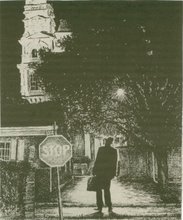Sunday, March 29, 2009
What Holds us Together
In the name of saving Gloucester, some of the very people who are promoting growth and development are destabilizing the one thing that makes Gloucester what it is—the primary quality that renders life at all tolerable and special here. And that is a sense of community.
Like many other natives, I’ve discovered the meaning of community as a result of living away from Gloucester. When I lived in Florence, Italy or among the Penobscot Indians of Maine, I responded, often as consequence of missing my home town, to a sense of community I felt in those quite separate cultures and places. What I experienced was a quality of shared institutions, of tradition, heritage, history and architecture. Along with these attributes, I found a sense of interdependence, of mutual responsibility; of people taking care of each other.
At bottom, this amounts to what some have called “a sense of place.” It is a combination of physical and spiritual qualities. It’s a chemistry between particular people and a unique landscape. It has to do with the way people react to that landscape, how they feel about it and themselves as part of it.
Often the place we live in, our very community, becomes invisible to us because of our long habit of simply being in it, of taking it for granted. We take the light of Gloucester for granted, as we do the configuration of buildings along the waterfront, the skyline above Main and Rogers streets: the hue of West End red brick, the reflection of the sun off the water of the inner harbor, or the way Ten Pound Island seems to loom closer to the land than it actually is on certain days of hazy sun or fog.
We take each other for granted, too. We think that fishermen will always be part of our lives here, that the waterfront will accommodate them because it always has. We take the availability of jobs for granted (or at least we did before the collapse of the world’s economy), of housing we can afford (or once could). We expect to wake up each morning and find the objects we take our bearings from—the flowering shad bush at the edge of Dogtown in the spring, the gulls in the harbor—in their habitual places and observing their special rhythms of appearance. We expect to do what we always do, to be who we think we are.
But the immediate world around us, or the sense of community we derive from simply being here—from our comfortableness with the ever-recurring patterns of life that are as precious to us as the blood flowing in our veins—doesn’t exist undisturbed or unchangeable forever. Community must be nurtured. It must be stabilized by good planning, enhanced by proper growth. It cannot be allowed to languish or deteriorate like an abandoned house. By the same token, it cannot sustain radical social, physical or economic change without suffering in ways both obvious and subtle. For when you destroy neighborhoods by driving long-time residents out; when you undermine deep-seated cultural traditions, like those which have accompanied maritime life; when you destabilize long-existing local businesses, you destroy a sense of community. You dismantle it piece by piece.
A case in point was the closing of neighborhood schools, beginning in the late 1970s. During the fight to save those schools, which formed part of the lifeblood of this community, proponents claimed that those who wished to keep them open were backward-looking. The wave of the future, they said (or at least the way under Proposition 2 ½) was to centralize. Ironically, the school department later regretted the closing of those five crucial neighborhood schools.
But the damage was done. Life in those neighborhoods was never the same as it was when the children walked to school and their parents could drop by and check on their progress or just visit. The intimate person-to-person experience of the neighborhood school—the small classes, the manageable environment—gave way to the anonymity of the large institution. The walk became the bus ride. And we’ve yet to ascertain the effects of these dislocations on the children themselves.
Community is a number of things, both visible and invisible. It is buildings and people, jobs and homes, traditions and values, all held together in a special kind of suspension. Community is the speech of the people. It’s the way we look and sound to each other and outsiders. When you are a part of the community you feel alive, secure. You know who you are and who your neighbor is. When you are away from community you realize what you miss. When you see change, or when inappropriate change seems imminent—when the real gives way to the fake; when a working community becomes little more than a bedroom for commuters, who have scant investment in that community—you begin to feel disoriented. The quality of your daily life is diminished.
Community is hard to define. But ultimately it is the “glue” that holds everything together in a place like Gloucester. And when that glue becomes unstuck, as it threatens to do with the development of a massive shopping center that is certain to undermine downtown businesses or the push to build a luxury hotel on the industrial waterfront, both of which run counter to everything a place like Gloucester stands for, all that it holds together comes loose or disintegrates. Community disappears and so do we and what we stand for along with it.
Subscribe to:
Posts (Atom)


